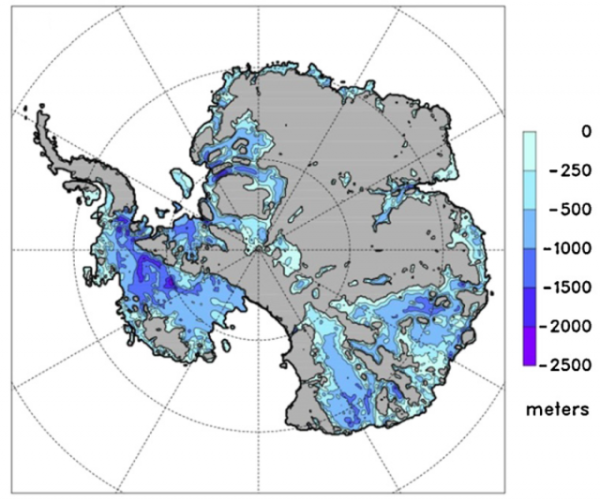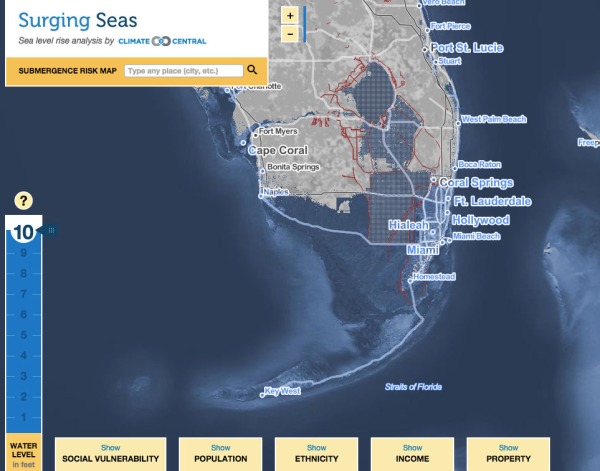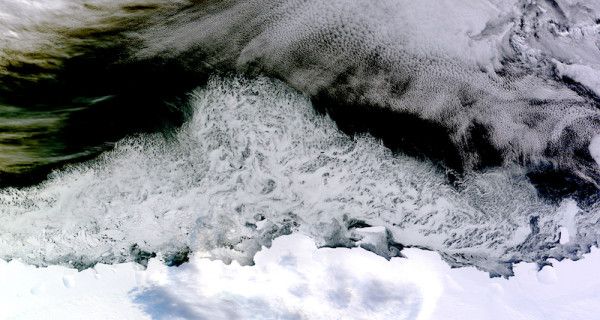Tottering Totten and the Coming Multi-Meter Sea Level Rise
25
May, 2016
A
new scientific study has
found that the Totten Glacier is fundamentally unstable and could
significantly contribute to a possible multi-meter sea level rise
this Century under mid-range and worst case warming scenarios.
*****
408
Parts per million CO2. 490 parts per million CO2e. This is the amount
of heat-trapping CO2 and total CO2 equivalent for all heat-trapping
gasses now in the Earth’s atmosphere. Two measures representing
numerous grave potential consequences.
We’re
Locking in 120-190 Feet of Sea Level Rise Long Term
Looking
at the first number — 408 parts per million CO2 — we find that
the last time global levels of this potent heat-trapping gas were so
high was during
the Middle Miocene Climate Optimum of 15-17 million years ago.
During this time, the Greenland Ice Sheet did not exist. East
Antarctic glacial ice was similarly scarce. And the towering glaciers
of West Antarctica were greatly reduced. Overall, global sea levels
were 120 to 190 feet higher than they are today. Meanwhile,
atmospheric temperatures were between 3 and 5 degrees Celsius hotter
than those experienced during the late 19th Century.
(Large
sections of Antarctica rest below sea level. A physical feature that
renders substantial portions of Antarctica’s glaciers very
vulnerable to rising ocean temperatures. Since the latent heat
content of water is substantially higher than that of air, even
comparatively small ocean temperature increases can cause significant
melt in sea-facing glaciers and in below sea level glacial basins.
Image source: Potential
Antarctic Ice Sheet Retreat Driven by Hydrofracturing and Ice Cliff
Failure.)
Hitting
the 408 ppm CO2 threshold this year catapults
the current push for global climate transitions outside of the
Pliocene context of 3 to 5 million years ago (topping out at 405
parts per million CO2) and places it in the bottom to mid-range of
the Middle Miocene context (300 to 500 parts per million CO2). The
490 ppm CO2e number — due to added atmospheric heating
contributions from human-emitted gasses like methane,
chlorofluorocarbons, NOx compounds, and others — is enough to
catapult our current climate context into the upper Middle Miocene
range.
If
global greenhouse gasses were to stabilize in this range long-term
(for a period of hundreds of years), we would expect the Earth’s
climate and ocean states to become more and more like those
experienced 15-17 million years ago.
Unfortunately, atmospheric
concentrations of heat trapping gasses are still rapidly rising due
to an increasingly dangerous emission coming from global fossil fuel
burning. In addition, risks are rising that the Earth System will
begin to contribute its own substantial amounts of carbon —
possibly enough to raise the CO2e number by around 50 to 150 ppm over
the next few centuries. Two contributions — one we control and
another we do not — that
risk swiftly pushing the global climate context into a 550 to 650 ppm
CO2e range that is enough to eventually melt all the glacial ice on
the planet.
Glacial
Inertia vs Lightning Rates of Warming
It’s
a tough climate state. A context that many scientists are still
having difficulty coming to grips with. First, the global glacier
research community is still looking at the world’s potential future
ice melt in Pliocene and Eemian contexts. This makes some sense given
the fact that current atmospheric warming in the range of 0.9 to 1.3
C above 1880s values is more in line with those two climate epochs
(the Eemian saw seas 10-20 feet higher than today and the Pliocene
saw seas at 25-75 feet higher). But it doesn’t take into account
the underlying heat forcing and the likely climate end-state.
Second,
we don’t really have a good grasp on how fast or slow glaciers will
respond to the added heat we’re putting into the Earth System. We
do know that at the end of the last ice age, melting glaciers
contributed as much as 10 feet of sea level rise per Century. But
this was during a time of comparatively slow global temperature
increase at the rate of about 0.05 C per Century — not the current
rate in the range of 1.5 to 2 C per Century, which is 30 to 40 times
faster.
(What
10 feet of sea level rise would do to South Florida. Given the
increasing vulnerability of glaciers around the world to human-forced
warming, there’s a rising risk that seas could rise by 10 feet
before the end of this Century. Image source: Climate
Central.)
In
early studies, much weight has been given to glacial inertia. And
older climate models did not include dynamic ice sheet
vulnerabilities — like high latent-heat ocean water coming into
contact with the submerged faces of sea-fronting glaciers, the
ability of surface melt water to break up glaciers by pooling into
cracks and forcing them apart (hydrofracturing), or the innate
rigidity and frailty of steep ice cliffs which render them
susceptible to rapid toppling. But now, new studies are starting to
take these physical melt-amplifying processes into account and the
emerging picture is one in which glacial melt and sea level rise may
end up coming on at rates far more rapid than previously feared.
Overall,
when taking a look at these newly realized ice-sheet weaknesses, it’s
worth noting that the total heat forcing impacting the world’s
ocean, air, and glacial systems is now rising into a range that is
much more in line with Middle Miocene values. And that global
temperatures are now increasing at a lightning rate that appears to
be unprecedented in at least the past 60 million years.
Tottering
Totten
It’s
in this dynamic, rapidly changing, and arguably quite dangerous
climate context that new revelations about the stability of one of
East Antarctica’s largest glaciers have begun to emerge. In size,
the Totten Glacier is immense — covering an area the size of
California in mountains of ice stretching as high as two and a half
miles. If all of Totten were to melt, it would be enough to raise
seas by around 11 to 13 feet — or about as much as if half of the
entire Greenland Ice Sheet went down.
(The
Totten Glacier, at lower edge of frame, faces a warming Southern
Ocean. How rapidly this great mass of ice melts will, along with the
destabilization of numerous other glaciers around the world due to a
human-forced warming, determine the fates of numerous coastal cities
and island nations during this Century and on into the future. Image
source: LANCE-MODIS.)
Last
year, a
study found that warm, deep circumpolar water was beginning to
approach ice faces of the Totten Glacier plunging 1 mile below the
surface of the Southern Ocean.
The study observed a
rapid thinning that appeared to have been driven by this new influx
of warmer ocean water near the glacier base:
Totten Glacier… has the largest thinning rate in East Antarctica. Thinning may be driven by enhanced basal melting… Warm modified Circumpolar Deep Water, which has been linked to glacier retreat in West Antarctica, has been observed in summer and winter on the nearby continental shelf beneath 400 to 500 m of cool Antarctic Surface Water…We identify entrances to the ice-shelf cavity below depths of 400 to 500 m that could allow intrusions of warm water if the vertical structure of inflow is similar to nearby observations. Radar sounding reveals a previously unknown inland trough that connects the main ice-shelf cavity to the ocean. If thinning trends continue, a larger water body over the trough could potentially allow more warm water into the cavity, which may, eventually, lead to destabilization of the low-lying region between Totten Glacier and the similarly deep glacier flowing into the Reynolds Trough (emphasis added).
Observed
increasing melt rates for such a huge slab of ice in Eastern
Antarctica was generally seen as a pretty big deal among glacial
scientists and a flurry of additional research soon followed. By last
week, a model study had found that
Totten alone could produce as much as 1 meter of sea level rise
before the end of this Century if
global temperatures warm by 2 degrees Celsius or more above 1880s
values. The study also found that 5 C worth of local ocean warming
would be enough to force nearly 3 meters worth of sea level rise from
this single large glacier over a relatively short time-frame.
“Totten Glacier’s catchment is covered by nearly 2½ miles of ice, filling a California-sized sub-ice basin that reaches depths of over one mile below sea level. This study shows that this system could have a large impact on sea level in a short period of time.”
Like
many large glaciers around the world, a huge portion of Totten’s
ice sits below sea level. This feature makes the glacier very
vulnerable to ocean warming. Water carries far more latent heat than
air and just a slight rise in local ocean water temperature can
contribute to rapid ice loss. Totten
itself rests in three large below sea level basins.
And study authors found that 2 C to 5 C warming of local ocean waters
with somewhat greater local air temperature increases was capable of
flooding these basins in stages — forcing Totten’s glacial ice to
flow out into the Southern Ocean and provide significant
contributions to sea level rise.
Unfortunately,
Totten is just one of many large glacial systems that are now
destabilizing across Antarctica. And ICECAP researchers now note that
Antarctica alone could contribute to as much as 2 meters worth of sea
level rise before the end of this Century. Such a figure does not
include Greenland’s own potential sea level rise contribution. Nor
does it include sea level rise from other glacial melt and ocean
thermal expansion. As such, it appears that multi-meter sea level
rise is becoming a more and more distinct possibility this Century.
Furthermore, the paleoclimate context is now pointing toward
catastrophic levels of overall melt and sea level rise if global
greenhouse gasses aren’t somehow stabilized and then swiftly
reduced.
Links:






No comments:
Post a Comment
Note: only a member of this blog may post a comment.